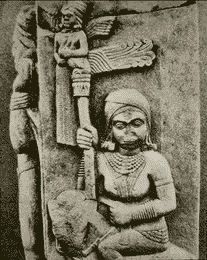 When it comes to divine love, Lord Krishna describes it best. Love, that captures the mind, where he conquers every mind at the same time, where each woman feels he belongs to her, where every man admires his relationship with Radha. What an amazing leela that would be!
When it comes to divine love, Lord Krishna describes it best. Love, that captures the mind, where he conquers every mind at the same time, where each woman feels he belongs to her, where every man admires his relationship with Radha. What an amazing leela that would be!Such divine chemistry, such charm experienced, where he grips the emotions and leaves the heart wishing for more. Krishna, probably defined love a lot differently. The Leelas of Radha and Krishna as described by Jayadeva bring alive love of a different nature, one that is selfless, and one that is of complete surrender.
Jayadeva places a condition before one attempts to read the divine love verses in the Gita Govinda.
yadi hari-smaraëe sarasaà mano
yadi viläsa-kaläsu kutühalam
madhura-komala-känta-padävaléà
çåëu tadä jayadeva-sarasvatém
"If your heart yearns to delight in remembrance of Sri Hari; if you are hankering to contemplate upon him with intense affection; if you are over whelmed with curiosity to know about his skill in amorous pastimes; then by all means read the Gita Govinda. You will relish my lovely poetry. Although it is so emotive and mellifluous, if you are not possessed of the aforementioned qualifications then you must not read it. This literature is not for you."
Although the issues of eligibility to read the Gita Govinda are clearly stated by Sri Jayadeva, the unqualified section of society fail to understand him and try reading this poetry with enthusiasm for its charming linguistic embellishment. They do not grasp the real significance of his verses and hold his compositions to be something crude. They are not inclined to enter into sweet contemplation of Lord Krishna as they remain confined to their experience of misidentifying themselves with the physical body and consider sensual gratification to being the ultimate limit of happiness. Such slaves of love cannot understand the meaning of transcendental love described by the poet.
Sri Chaitanya-Charitamrita states:
(Ädi-lilä 4.164–66):
käma, prema—dõhäkära vibhinna lakñaëa
lauha ära hema yaiche svarüpe-vilakñaëa
ätmendriya-préti-väïchä—täre bali ‘käma’
kåñëendriya-préti-icchä dhare ‘prema’ näma
kämera tätparya—nija-sambhoga kevala
kåñëa-sukha-tätparya—prema mahä-bala
"The characteristics of worldly lust and transcendental love are completely different. If mundane lust is likened to iron then spiritual love can be likened to gold. The desire to give satisfaction to one’s own senses is called lust. However, the desire to satisfy the senses of Sri Krishna is called pure love or prema. The goal of lust is one’s own enjoyment, whereas the purpose of love is to please Sri Krishna. Such prema is immensely powerful."
Sri Jayadeva Goswamy has defined the qualifications required to read this poem:
yadi hari-smaraëe sarasaà mano
yadi viläsa-kaläsu kutühalam
madhura-komala-känta-padävaléà
çåëu tadä jayadeva-sarasvatém
"If you want your mind to be deeply attached to the constant remembrance of Sri Hari, or your heart is already absorbed in contemplation upon him; and if you are curious to taste the mellows of his pastimes – that is, you hanker exclusively for this and for nothing else – then by all means listen to these gentle, appealing and honeyed verses of the transcendental poetry of Jayadeva."
The poetry of Jayadeva is a literary work that needs to be imbibed, and realized in the pursuit of one's own spiritualism. Be it Krishna or Lord Shiva, the path in devotion is the same, bhava needs to be felt, mano laya needs to be achieved.
As the Bhagavad Geeta states:
ManushyANAm sahasrEshu kaschidyathi siddhayE
yathathAmapi siddhAnAm kaschinmAm vEtthi ttatvaha
7-3
There are a lot of people but only a few are inclined to enter into the spiritual path. Out of these, fewer still pray deeply for liberation of the soul from the constant cycle of birth and death. From this handful of people, only one turns out to be the blessed one. It is metaphorically compared to flowers. There are many flowers but only a few are entitled to be offered to God. Out of these only a few are plucked and offered to God in prayer and finally only one flower reaches His bossom. Even if one steps into the spiritual path, it is difficult to pursue it till the end. Self realization requires dedication, and will power, sacrifice, control over the senses and equanimity.
Courtesy:
Stories of Bhaktas (telugubhakti.com)
Sri Gita-Govinda of Sri Jayadeva Gosvami

























